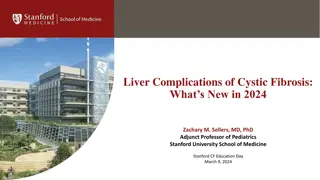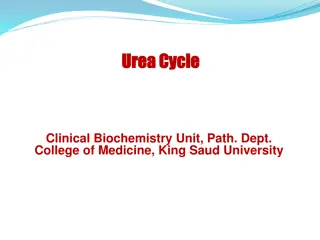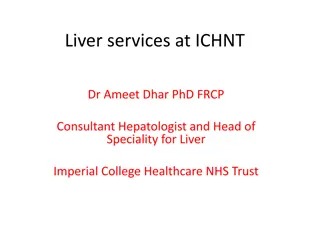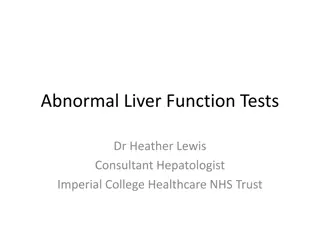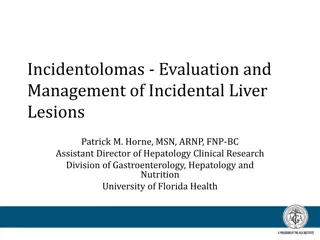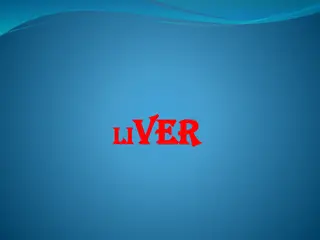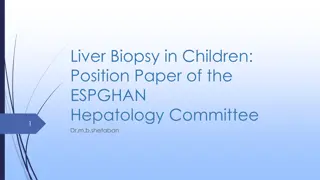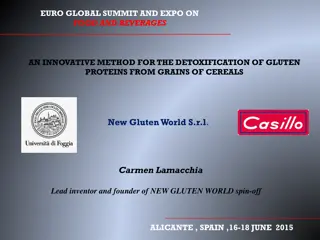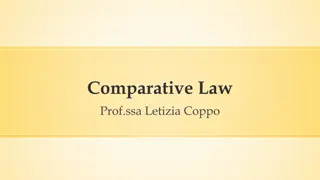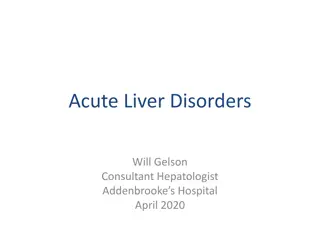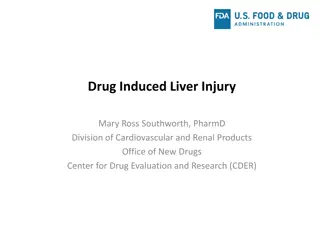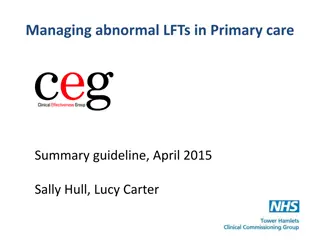Understanding Liver Detoxification and Harmony in Traditional Chinese Medicine
The liver plays a crucial role in detoxification and maintaining harmony in the body according to Traditional Chinese Medicine (TCM). Issues like liver disharmony can lead to various symptoms and health conditions. TCM emphasizes the importance of supporting liver function for overall well-being by addressing stress, emotions, and proper flow of qi and blood. Learn more about liver functions, symptoms of liver-related disorders, and the significance of detoxification in TCM principles.
Download Presentation

Please find below an Image/Link to download the presentation.
The content on the website is provided AS IS for your information and personal use only. It may not be sold, licensed, or shared on other websites without obtaining consent from the author. Download presentation by click this link. If you encounter any issues during the download, it is possible that the publisher has removed the file from their server.
E N D
Presentation Transcript
GU ADVANCED HERBAL STUDIES: DETOXIFICATION & LIVER DISHARMONY Hillary Thing, LAc., Cert. Herbalist (NCCAOM)
Functions of the Liver Functions of the Liver Carbohydrate, fat and protein metabolism Filtering and detoxification of the blood from drugs, alcohol, hormones, toxins, emotional and physiological metabolic waste Storage of iron and vitamins Formation of substances for blood coagulation Produces many types of enzymes Produces secretions to aid proper absorption and elimination of foods and toxins. Releases bile
Common Liver Common Liver- -related TBD symptomology related TBD symptomology Loss of appetite (23%) Nausea (17%) & vomiting (10%) Abdominal pain (8%) & URQ tenderness (8%) Hepatomegaly (5%) Liver inflammation w/ elevated enzymes in both acute and persistent Lyme-Borreliosis Hepatitis presentation is common with Ehrlichia (80%) Known cases of acute liver failure due to Babesia, Bartonella
Excessive burden on the liver makes it a pivotal Excessive burden on the liver makes it a pivotal organ in Lyme / TBD / CCD organ in Lyme / TBD / CCD Direct attack, infection of liver Higher toxin load due to endotoxins Genetic weaknesses Antibiotics & pharmaceuticals Sluggish circulation Nutrient depletion
Characteristics of the Liver in Chinese Characteristics of the Liver in Chinese Medicine: Medicine: Deals with coping, stress management, and harmonizing emotion our ability to flow with life. The General: commands the flow of qi and blood; pathology reflected in excessive rigidity and over-flexibility; (bamboo) The primary underlying organ dysfunction of all chronic disease syndromes. When the liver loses harmony, the Spleen (digestion) may be affected; digestive issues are a common side-effect of stress and unresolved emotions. Hallmark sx: PMS and hormonal problems, headaches, eye problems, infertility, allergies, obesity, herpes, digestive problems, constipation, heart and circulatory problems, and cancer signify pre-existing liver disharmony. Liver constraint produces anger, irritability or in severe cases rage.
Detoxification & the Harmonization School of Detoxification & the Harmonization School of Chinese Medicine Chinese Medicine Founder was Cheng Wu-Ji from the Song D.; strongly influenced by the Shang Han Lun. The body is constantly struggling between exterior and interior forces and levels of disease, so emphasis on the shaoyang (1/2 interior, exterior) level of disease; the axis of this struggle is in the chest. Psych: this strategy works with stuck perspective, loss of flexibility, negative thoughts, isolation and judgement (defense mechanisms). Chief herb is bupleurum / chai hu.
Treatment Principle for Liver Harmony & Treatment Principle for Liver Harmony & Detoxification in Gu Disease Detoxification in Gu Disease 1. Reduce incoming toxins (examine bodycare, home & work environments, etc.) 2. Strengthen Spleen, reduce damp, treat leaky gut and other GI problems. 3. Move stagnant Liver qi & blood. 4. Nourish liver yin & blood. 5. Transform Liver / Gallbladder damp-heat. 6. Clear heat (deficiency or excess). 7. Eliminate Wind. 8. Nourish the Kidneys. 9. Eliminate specific microbial infections. 10. Break up biofilm.
Bupleurum Bupleurum- -Based Formulas: Hallmarks of Gu Based Formulas: Hallmarks of Gu Clinical Presentation Clinical Presentation Chest / ribcage fullness, discomfort, stuckness; subjective or on palpation; stress-related sx; constrained breathing Alternating fever and chills; episodic, rhythmic sx Shaoyang zone: chest, ribcage, shoulders, hips, nape, lateral head, torso and legs. Tendency for qi stagnation and blood stasis CNS hyperactivity; insomnia; seizures; Neuro-lyme; headaches All formulas are safe and commonly used in pediatrics.
Chai hu, Bupleurum root, Chai hu, Bupleurum root, thorowax thorowax root root Kindling of the barbarians Enters Gallbladder, Liver, Pericardium, San Jiao Cool, acrid, bitter 1. Releases shaoyang (1/2 interior, exterior) conditions Alternating constipation / diarrhea, alternating fever / chills; nausea, bitter taste, irritability 2. Releases constrained Liver Qi Pent up, stagnant feeling, bloating, indigestion, vague type pain / pressure, moody, menstrual disorders 3. Raises yang qi and vents the surface (combine with sheng ma / black cohosh) Prolapse, diarrhea, rashes
Classical Formulas for Liver Detoxification Classical Formulas for Liver Detoxification Xiao Chai Hu Tang Xiao Yao Wan Jia Wei Xiao Yao Wan Chai Hu Shu Gan San (Wan Golder Flower) Xue Fu Zhu Yu Wan Tao Hong Si Wu Tang Yi Guan Jian Chai Hu Long Gu Mu Li Tang
Minor Bupleurum Decoction / Xiao Chai Hu Minor Bupleurum Decoction / Xiao Chai Hu Tang Tang From Shang Han Lun (Zhang Zhong-Jing), 220 ADa Ingredients: Bupleurum / chai hu. 10 g Scutellaria / huang qin. 6 g Zhi ban xia / processed pinellia rhizome. 6g Ginseng / ren shen 5g -> huang qi fresh ginger / sheng jiang. 10 g Licorice / gan cao. 10g Jujube / da zao. 12g Tx hepatitis, cholecystitis, URTI, UTI, GI inf, encephalitis, etc. Fever, bitter taste, indigestion, irritability & expressive depression, Wiry pulse, yellow tongue coating
Bupleurum, Cinnamon Twig & Dried Ginger Bupleurum, Cinnamon Twig & Dried Ginger Decoction / Chai hu Decoction / Chai hu Gui Gui zhi zhi Gan jiang Tang Gan jiang Tang From Shang Han Lun (Zhang Zhong-Jing), 220 ADa Ingredients: Bupleurum / chai hu. 24 g Trichosanthes root / tian hua fen. 12 g or gua lou / (fruit) Oyster shell / mu li. 6 g Cinnamon twig / gui zhi. 9g Scutellaria / huang qin. 9 g Dried ginger / gan jiang. 6 g Honey fried licorice / zhi gan cao 6 g -> gan cao Releases phlegm and qi stagnation in the chest; Helps person find their sense of direction; emotionally drained. Calming + restores energy; nervous system fragility; unstable energy levels due to stress.
Chai Hu Jia Long Gu Mu Li Tang / Bupleurum, Chai Hu Jia Long Gu Mu Li Tang / Bupleurum, Dragon Bone & Oyster Shell Decoction Dragon Bone & Oyster Shell Decoction Shang Han Lun, Discussion of Injury by Cold, 220AD Ingredients: Bupleurum / chai hu. 12 g Cinnamon twig / gui zhi. 4.5 g Rhubarb / da huang. 6 g Pinellia / ban xia. 6-9 g Scutellaria / huang qin. 4.5 g Fresh ginger / sheng jiang. 4.5 g Poria / fu ling. 4.5 g Ginseng / ren shen 4.5 g Dragon bone / long gu. 4.5 g Oyster shell / mu li. 4.5 g Jujube / da zao. 6 pc **For neuro-psych presentations. Panic, anxiety, HT palp; neuro-muscular pathologies Tx acute stress, SAD, illness worsened by stress, environmental or hormonal changes EPF + interior deficiency; good for chronic conditions
Free Wanderer Powder / Xiao Yao San Free Wanderer Powder / Xiao Yao San Tai Ping Hui Min He Ji Ju Fang, 1078AD (Imperial Medicine) Ingredients: Chai hu / Bupleurum root Bai zhu / Atractylodes -> huang qi / astragalus Bai shao / White Peony root Fu ling / Poria Dang gui / Angelica Sinensis Sheng jiang / fresh ginger root Bo he / Field mint Gentler formula for stress-related and hormone-related symptom aggravation. Jia Wei Xiao Yao San: classic modification adds zhi zi / gardenia + mu dan pi / moutan peony root bark to also clear heat
Da Chai Hu Tang / Major Bupleurum Decoction Da Chai Hu Tang / Major Bupleurum Decoction Shang Han Lun, 220 AD Ingredients: Chai hu / bupleurum. 10g Huang qin / scutellaria. 6g Bai shao / white peony root. 6g Ban xia / pinellia. 6g. Sheng jiang / fresh ginger. 1 slice, add last Zhi shi / citrus aurantium. 6g Da zao / jujube. 10g Da huang / rhubarb. 5g. Constipation, heat signs (fever, irritability, redness, etc.) If constipation does not resolve, add rhubarb in last 5 minutes of decoction. Tx GB, pancreas, liver, GI inflammation; if Minor Bupleurum is not strong enough
Gu Detox Formula Checklist Gu Detox Formula Checklist Is this strategy included in the formula? Does the patient need this, and if so, in what proportion? Move liver qi Move liver blood Nourish liver blood Nourish liver yin Nourish kidney yin and yang Strengthen the Spleen (GI), eliminate damp, heal leaky gut Eliminate wind (neuro) Clear heat excess or deficiency Drain liver / gallbladder damp-heat Address specific microbial infections Break up biofilm
Modern Gu Detox Formulas Modern Gu Detox Formulas Liver Detox Formula (UL) Kidney Detox Formula (UL) Heavy Metal Detox Formula (UL)
Liver Gu Liver Gu- -Detox Formula (UL) Detox Formula (UL) Actions: Support detoxification pathways and the movement of blood through the liver; anti-oxidant and liver protective; anti-inflammatory; treats gallbladder congestion too. Ingredients: Chai hu / bupleurum Dang gui / angelica sinensis Milk thistle Xiang fu / cyperus Bai shao / white peony Huang qin / scutellaria Zhi zi / gardenia Pu gong ying / dandelion Yu jin / curcuma Yin chen hao / artemisia yinchenhao Jin qian cao / lysimachia Available in raw herb, granule or tincture
Kidney Gu Kidney Gu- -Detox Formula (UL) Detox Formula (UL) Actions: Aids the movement of water through the kidneys; supports kidney s filtering function; anti-inflammatory. Ingredients: Ze xie / alisma Fu ling / poria Zhu ling / polyporus Gui zhi / cinnamon twig Mu zei / horsetail Yu mi xu / cornsilk Huang bai / phellodendron Che qian zi / plantain seeds Available in tea, granule and tincture forms (UL)
Heavy Metal Detox Formula (UL) Heavy Metal Detox Formula (UL) Actions: Neutralizes poisons, facilitates binding, replaces minerals, and stimulates excretion of the heavy metals. Ingredients: Dang gui / angelica sinensis Tu fu ling / smilax Fang feng / ledeboriella Jin qian cao / lysimachia herb Ji xue teng / milletia Mu zei / horsetail Ban lan gen / isatis Chi shi zhi / Halloysite (kaolin) Shan yao / dioscorea Gan cao / licorice Available in tea, granule and tincture forms.
REFERENCES REFERENCES 1. Stephen Buhner, Natural Treatments for Lyme Coinfections, Anaplasma, Babesia, and Ehrlichia, 2014, Healing Arts Press. James Schaller MD MAR, Kimberly Mountjoy, MS, What You May Not Know About Bartonella, Babesia, Lyme Disease, and Other Tick & Flea-Borne Infections, 2012, International University Infectious Disease Press http://www.labome.org/research/Granulomatous-hepatitis-associated-with-chronic-Borrelia-burgdorferi- infection-a-case-report.html Babesiosis presenting as acute liver failure. https://www.ncbi.nlm.nih.gov/pmc/articles/PMC5803690/ Research Open Access 2014;1:875. Read the full article: http://dx.doi.org/10.13070/rs.en.1.875. Granulomatous hepatitis due to Bartonella henselae infection in an immunocompetent patient. https://www.ncbi.nlm.nih.gov/pmc/articles/PMC3287964/ Syed Ali Zaidi, Carol Singer; Gastrointestinal and Hepatic Manifestations of Tickborne Diseases in the United States, Clinical Infectious Diseases, Volume 34, Issue 9, 1 May 2002, Pages 1206 1212, https://doi.org/10.1086/339871 Treatment of Lead Poisoning and Other Environmental Diseases by Chinese Herbal Medicine. Subhuti Dharmananda, PhD, ITM, June 1993 Huang, huang. 10 Key Formula Families. Eastland Press, 2009. Yuen, Jeffrey. Personal notes from lectures 2000-2005. 2. 3. 4. 5. 6. 7. 8. 9. 10.





